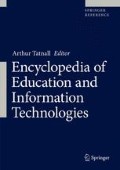Access this chapter
Tax calculation will be finalised at checkout
Purchases are for personal use only
References
Armoni M (2013) On teaching abstraction in computer science to novices. J Comp Math Sci Teach 32(3):265–284
Bers MU (2017) Coding as a playground: programming and computational thinking in the early childhood classroom. Taylor & Francis. Available at: https://books.google.co.uk/books?id=iWEwDwAAQBAJ
Bers MU, Flannery LP, Kazakoff ER, Sullivan A (2014) Computational thinking and tinkering: exploration of an early childhood robotics curriculum. Computers & Education 72:145–157
Cockburn A (2002) Agile software development. Addison-Wesley, Boston
College Board (2017) AP Computer Science Principles: Curriculum Framework 2016-2017 USA (PDF). Retrieved 23rd April 2019 Available at: http://secure-media.collegeboard.org/digitalServices/pdf/ap/ap-computerscience-principles-course-and-exam-description.pdf
Csizmadia A, Curzon P, Dorling M, Humphreys S, Ng T, Selby C, Woollard J (2015) Computational Thinking a Guide for Teachers. Retrieved 23rd April 2019 Available at: http://community.computingatschool.org.uk/files/6695/original.pdf
Department Of Education (2013) Computing programmes of study key stages 1 and 2 national curriculum in England. Department of Education. Available at: https://www.gov.uk/government/publications/national-curriculum-in-england-computing-programmes-of-study
Dockrell J, Marshall C, Wyse D (2015) Education endowment fund talk for writing evaluation report and executive summary. Available at: https://educationendowmentfoundation.org.uk/public/files/Projects/Evaluation_Reports/EEF_Project_Report_TalkForWriting.pdf
Graham S, Perin D (2007) A meta-analysis of writing instruction for adolescent students. J Educ Psychol 99(3):445
Grover S, Pea R, Cooper S (2015) Designing for deeper learning in a blended computer science course for middle school students. Comp Sci Educ 25(2):199–237
Hansen A et al. (2016) Differentiating for diversity: using universal design for learning in elementary computer science education. In: Proceedings of the 47th ACM technical symposium on computing science education (SIGCSE ’16). ACM, New York, 376–381. https://doi.org/10.1145/2839509.2844570
K-12 Computer Science Framework Steering Committee and Others (2016) K-12 computer science framework. Technical report. ACM, New York, Available online http://www.k12cs.org
Kafai YB, Resnick M (eds) (1996) Constructionism in practice: designing, thinking, and learning in a digital world. Lawrence Erlbaum Associates, Mahwah
Kafai YB, Vasudevan V (2015) Constructionist gaming beyond the screen: middle school students’ crafting and computing of touchpads, board games, and controllers. In: Proceedings of the workshop in primary and secondary computing education (WiPSCE ’15). ACM, New York, 49–54. https://doi.org/10.1145/2818314.2818334
Kastl P, Romeike R (2015) Now they just start working, and organize themselves first results of introducing agile practices in lessons. In: Proceedings of the workshop in primary and secondary computing education (WiPSCE ’15). ACM, New York, 25–28. https://doi.org/10.1145/2818314.2818336
Missiroli M, Russo D, Ciancarini P (2016) Learning Agile software development in high school: an investigation. In: Proceedings of the 38th international conference on software engineering companion (ICSE ’16). ACM,New York, 293–302. https://doi.org/10.1145/2889160.2889180
Perrenet J, Groote JF, Kaasenbrood E (2005) Exploring students’ understanding of the concept of algorithm: levels of abstraction. ACM SIGCSE Bulletin 37(3):64–68
Schulte C et al. (2017) The design and exploration cycle as research and development framework in computing education. In: Global engineering education conference (EDUCON), 2017 IEEE. IEEE, 867–876. Athens, Greece Available online https://dblp.org/db/conf/educon/educon2017
Schunk DH, Swartz CW (1993) Goals and progress feedback: effects on self-efficacy and writing achievement. Contemp Educ Psychol 18(3):337–354
Soloway E (1986) Learning to program = learning to construct mechanisms and explanations. Commun ACM 29(9):850–858
Tedre M, Denning PJ (2016) The long quest for computational thinking. In Proceedings of the 16th Koli Calling International Conference on Computing Education Research (Koli Calling ’16). ACM, New York, 120–129. https://doi.org/10.1145/2999541.2999542
Tracy B, Reid R, Graham S (2009) Teaching young students strategies for planning and drafting stories: the impact of self-regulated strategy development. J Educ Res 102(5):323–332
Turkle S, Papert S (1990) Epistemological pluralism: styles and voices within the computer culture. Signs 16(1):128–157
Waite J (2017) Pedagogy in teaching computer science in schools: a literature review (After the reboot: computing education in UK schools). Available at: https://royalsociety.org/~/media/policy/projects/computing-education/literature-review-pedagogy-in-teaching.pdf
Waite J et al. (2016) Abstraction and common classroom activities. In: Proceedings of the 11th workshop in primary and secondary computing education (WiPSCE ’16). ACM, New York, 112–113. https://doi.org/10.1145/2978249.2978272
Waite J et al. (2017) K-5 teachers’ uses of levels of abstraction focusing on design. In: Proceedings of the 12th workshop in primary and secondary computing education (WiPSCE ’17). Erik Barendsen and Peter Hubwieser (Eds.). ACM, New York, 115–116. https://doi.org/10.1145/3137065.3137068
Whitebread D, Basilio M (2012) The emergence and early development of self-regulation in young children. Profesorado, Revista de Currıculum y Formación del Profesorado 16(1):15–34
Wing JM (2008) Computational thinking and thinking about computing. 366. Philosophical Transactions of the Royal Society A: Mathematical, Physical and Engineering Sciences, London. https://doi.org/10.1098/rsta.2008.0118
Author information
Authors and Affiliations
Corresponding author
Editor information
Editors and Affiliations
Rights and permissions
Copyright information
© 2020 Springer Nature Switzerland AG
About this entry
Cite this entry
Waite, J. (2020). Design in K-5 Programming Projects, Role of. In: Tatnall, A. (eds) Encyclopedia of Education and Information Technologies. Springer, Cham. https://doi.org/10.1007/978-3-030-10576-1_137
Download citation
DOI: https://doi.org/10.1007/978-3-030-10576-1_137
Published:
Publisher Name: Springer, Cham
Print ISBN: 978-3-030-10575-4
Online ISBN: 978-3-030-10576-1
eBook Packages: Computer ScienceReference Module Computer Science and Engineering

